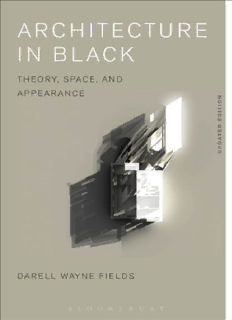Table Of ContentArchitecture in Black
Also Available From Bloomsbury
Aesthetics and Architecture, Edward Winters
Aesthetics: Key Concepts in Philosophy, Daniel Herwitz
Art, Myth and Society in Hegel’s Aesthetics, David James
The Missed Encounter of Radical Philosophy with Architecture, edited by Nadir
Lahiji
Architecture in Black
Theory, Space, and Appearance
Darell Wayne Fields
With a Foreword by
Cornel West
To Kathleen and Jessie
Contents
List of Illustrations
Acknowledgments
Introduction to Second Edition
Foreword (First Edition)
Part I Theory
Forethought: On Blackness and Time
Introduction to Part I
1 Hegel’s Tropes: History, Architecture, and the Black Subject
Philosophy and aesthetics: A total model of history
The subject identified
Full force of the effect: The negation of the Black Subject
The symbolic category: Architecture’s blackness
Transcending the Black Subject
2 Scheming the Scheme: The Technique of Revision
A racial model of the dialectic
The consistency of ideas
A comprehensive diagram
A linguistic revision of Aesthetics
Reintroduction of the Black Subject
3 Tropological Cases: The Racial Subject in Architectural Discourse
Signification of the first order: Laws of emergence
Signification of the second order: Operations on a black signifier
Contemporary architectural theory: Talking black
Afterthought: A Monkey Reading … Fanon
Part II Orders of Space and Appearance
Forethought: The Negative Constructs
Introduction to Part II
4 Black Autonomy
The Classical (P)eriod
Space and time: Kant and the indivisible
The medieval as symbolic: An other space, another time
Kant, blackness, and autonomy: Toward a black formalism
5 Space and Time in the Classical (P)eriod
From space to appearance
Spatial orders in The Birth of Tragedy
Visualizing autonomy: A reflection on the history of styles
The spatial diagrammatic
6 Architecture and the Classical (P)eriod
Building on language: Black Architectonics
Spatial linguistics and the hall of mirrors
The Black Architectonic: A methodological note
Now imagine a monkey sitting in a dark place trying to see architecture for
the first time
Afterthought: The End: Of Absence
Works Cited
Index
List of Illustrations
F.1 Becoming, J.L. Fields, 2014
2.1 Hegel, Schopenhauer, and Gonineau: a comprehensive
historical/racial table (by author)
2.2 Double diagram, Henry Louis Gates, Jr, 1988. From The Signifying
Monkey: A Theory of African-American Literary Criticism, Oxford
University Press
2.3 A comparative structure of the linguistic sign and resulting forms of
signification (by author)
3.1 Watkin’s and Pevsner’s historical definitions of architecture
superimposed on a diagram representing Gates’s black vernacular
(by author)
3.2 Agrest and Gandelsonas’s theoretical definitions of architecture
superimposed on a diagram representing Gates’s black vernacular
(by author)
6.1 A comparative structure of formal principles of language and
spatial types (by author)
6.2 Saussure’s linguistic plane versus Gates’s linguistic projection (by
author)
6.3 Totemic Operator, C. Lévi-Strauss, 1966. From The Savage Mind.
Courtesy of the University of Chicago Press
6.4 House for Josephine Baker. Adaptation of Lévi-Strauss’s Totemic
Operator (by author)
6.5 The Black Architectonic diagram. Adaptation of Lévi-Strauss’s
Totemic Operator (by author)
6.6 Intentionally Left Black I (by author)
6.7 Intentionally Left Black II (by author)
6.8 Cenotaph for Sir Isaac Newton, Étienne-Louis Boullée, 1784
6.9 House of the Agricultural Guards of Maupertuis, section, Claude-
Nicolas Ledoux, ca. 1780
6.10 Solohouse, Lebbeus Woods, 1988–9
6.11 Berlin 1983, John Hejduk, 1983
6.12 House for Kara Walker, Darell Wayne Fields, 2011
6.13 2611 Exline 2611 Exline, Darell Wayne Fields, 2011
6.14 Hatcher Street Cenotaph, Darell Wayne Fields, 2011
6.15 Black Signifier, Darell Wayne Fields, 2011
Acknowledgments
Since the original publication of Architecture in Black, at the turn of the last
century, a lot has changed. I acknowledge distant friends and estranged mentors.
Most are mentioned, there, in the acknowledgments of the first edition.
Becoming “distant” is a result, perhaps, of being bound to, and pulled apart by,
our respective convictions. Regardless, I remain indebted to them all.
Unexpectedly, there are the new acquaintances. Those, unknown initially, who
reach out offering opportunities that re-enliven the spirit. I am deeply indebted to
CentralTrak, The University at Dallas Artists Residency, and its former Director,
A. Kate Sheerin. Time spent during my residency (2010–11) allowed me to
visualize the theory of the “architecture in black” project. The results of those
reflections are published here for the first time. I also thank Colleen Coalter,
Commissioning Editor of Philosophy at Bloomsbury Publishing, for her
unexpected enquiry resulting in the publication of the second edition.
Finally, there are those who seem to have always been with us. Who, with the
force of objective intellect, regardless of change, demand that we move forward
along a principled path. To her, Kathleen Fields, I dedicate the entirety of this
work as a demonstration of my ongoing efforts, with her guidance, to do just
that.
Description:Based on analysis of historical, philosophical, and semiotic texts, Architecture in Black presents a systematic examination of the theoretical relationship between architecture and blackness. Now updated, this original study draws on a wider range of case studies, highlighting the racial techniques

